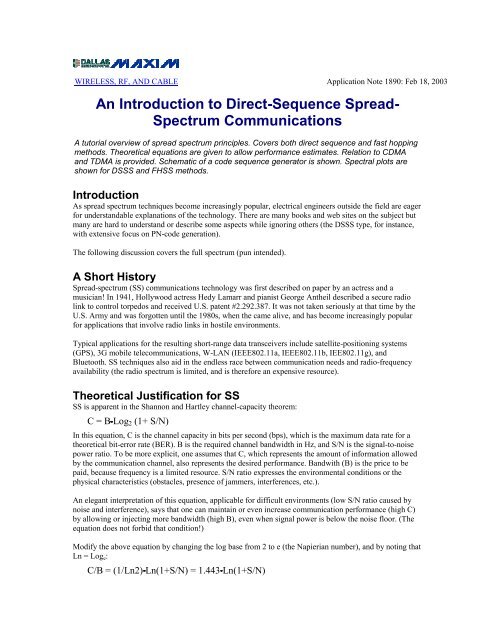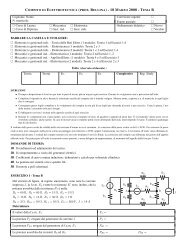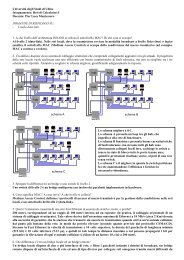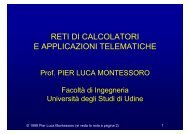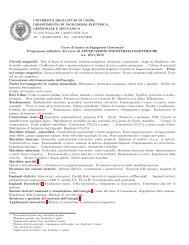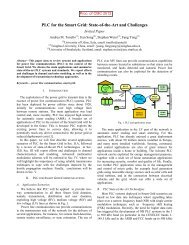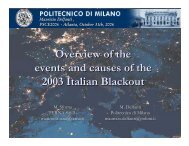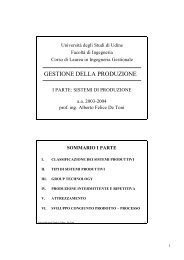An Introduction to Direct-Sequence Spread-Spectrum ... - diegm
An Introduction to Direct-Sequence Spread-Spectrum ... - diegm
An Introduction to Direct-Sequence Spread-Spectrum ... - diegm
Create successful ePaper yourself
Turn your PDF publications into a flip-book with our unique Google optimized e-Paper software.
Figure 4.SS is Wideband TechnologyAs opposed <strong>to</strong> regular narrowband technology, the SS process of spreading is a wideband technology. W-CDMA and UMTS, for example, are wideband technologies that require a relatively large frequencybandwidth (compared <strong>to</strong> that of narrowband radio).Resistance <strong>to</strong> Interference, and <strong>An</strong>ti-jamming EffectsThis characteristic is the real beauty of SS. Intentional or un-intentional interference and jamming signalsare rejected because they do not contain the SS key. Only the desired signal, which has the key, will beseen at the receiver when the despreading operation is exercised.Figure 5.You can practically ignore the interference (narrowband or wideband) if it does not include the key used inthe despreading operation. That rejection also applies <strong>to</strong> other SS signals not having the right key, whichallows different SS communications <strong>to</strong> be active simultaneously in the same band (such as CDMA). Notethat SS is a wideband technology, but the reverse is not true. Wideband techniques need not involve SStechnology.Resistance <strong>to</strong> InterceptionResistance <strong>to</strong> interception is the second advantage provided by SS techniques. Because non-authorizedlisteners do not have the key used <strong>to</strong> spread the original signal, they cannot decode it. Without the rightkey, the SS signal appears as noise or as an interferer (scanning methods can break the code, however, ifthe key is short.) Even better, signal levels can be below the noise floor, because the spreading operationreduces the spectral density (<strong>to</strong>tal energy is the same, but it is widely spread in frequency). The message isthus made invisible, an effect that is particularly strong with the DSSS technique. Other receivers cannot"see" the transmission; they only register a slight increase in the overall noise level!
Figure 6.Resistance <strong>to</strong> Fading (Multipath Effects)Wireless channels often include multiple-path propagation, in which the signal has more than one pathfrom the transmitter <strong>to</strong> the receiver. Such multipaths can be caused by atmospheric reflection or refraction,and by reflection from the ground or from objects such as buildings.Figure 7.The reflected path (R) can interfere with the direct path (D) in a phenomenon called fading. Because thedespreading process synchronizes <strong>to</strong> signal D, signal R is rejected even though it contains the same key.Methods are available <strong>to</strong> use the reflected-path signals by despreading them and adding the extractedresults <strong>to</strong> the main one.SS Allows CDMANote that SS is not a modulation scheme, and should not be confused with other types of modulation. Onecan, for example, use SS techniques <strong>to</strong> transmit a signal modulated via FSK or BPSK. Thanks <strong>to</strong> the codingbasis, SS can also be used as another method for implementing multiple access (the real or apparentcoexistence of multiple and simultaneous communication links on the same physical media). So far, threemain methods are available:FDMA: Frequency Division Multiple Access. FDMA allocates a specific carrier frequency <strong>to</strong> acommunication channel, and the number of different users is limited <strong>to</strong> the number of slices in thefrequency spectrum. FDMA is the least efficient in term of frequency-band usage. Methods of FDMAaccess include radio broadcasting, TV, AMPS, and TETRAPOLE.Figure 8.TDMA: Time Division Multiple Access. Here, the different users speak and listen <strong>to</strong> each other according<strong>to</strong> a defined allocation of time slots. Different communication channels can then be established for a uniquecarrier frequency. Examples of TDMA are GSM, DECT, TETRA, and IS-136.
Figure 9.CDMA: Code Division Multiple Access. CDMA access <strong>to</strong> the air is determined by a key or code. In thatsense, spread spectrum is a CDMA access. The key must be defined and known in advance at thetransmitter and receiver ends. Growing examples are IS-95 (DS), IS-98, Blue<strong>to</strong>oth, and WLAN.Figure 10.One can, of course, combine the above access methods. GSM, for instance, combines TDMA and FDMA.It defines the <strong>to</strong>pological areas (cells) with different carrier frequencies, and sets time slots within each cell.<strong>Spread</strong> <strong>Spectrum</strong> and (De)coding "Keys"At this point, we know that the main SS characteristic is the presence of a code or key, which must beknown in advance by the transmitter and receiver(s). In modern communications, the codes are digitalsequences that must be as long and as random as possible <strong>to</strong> appear as "noise-like" as possible. But in anycase, they must remain reproducible. Otherwise, the receiver will be unable <strong>to</strong> extract the message that hasbeen sent. Thus, the sequence is "nearly random." Such a code is called a pseudo-random number (PRN) orsequence. The method most frequently used <strong>to</strong> generate pseudo-random codes is based on a feedback shiftregister:
Figure 11.Many books are available on the generation of PRNs and their characteristics, but that development isoutside the scope of this basic tu<strong>to</strong>rial. We simply note that the construction or selection of propersequences (or sets of sequences) is not trivial. To guarantee efficient SS communications, the PRNsequences must respect certain rules, such as length, au<strong>to</strong>-correlation, cross-correlation, orthogonality, andbits balancing. The more popular PRN sequences have names: Barker, M-<strong>Sequence</strong>, Gold, Hadamard-Walsh, etc. Keep in mind that a more complex sequence set provides a more robust SS link. But, the price<strong>to</strong> pay is a more complex electronics (both in speed and behavior), mainly for the SS despreadingoperations. Purely digital SS despreading chips can contain more than several million equivalent 2-inputNAND gates, switching at several tens of megahertz.
Different Modulation <strong>Spread</strong>ing Techniques for <strong>Spread</strong><strong>Spectrum</strong>Different SS techniques are distinguished according <strong>to</strong> the point in the system at which a pseudo-randomcode (PRN) is inserted in the communication channel. This is very basically illustrated in the here belowRF front end schematic :Figure 12.If the PRN is inserted at the data level, we have the direct sequence form of spread spectrum (DSSS). (Inpractice, the pseudo-random sequence is mixed or multiplied with the information signal, giving animpression that the original data flow was "hashed" by the PRN.) If the PRN acts at the carrier-frequencylevel, we have the frequency hopping form of spread spectrum (FHSS). Applied at the LO stage, FHSSPRN codes force the carrier <strong>to</strong> change or hop according <strong>to</strong> the pseudo-random sequence. If the PRN acts asan on/off gate <strong>to</strong> the transmitted signal, we have a time hopping spread spectrum technique (THSS). Thereis also the chirp technique, which linearly sweeps the carrier frequency in time. One can mix all the abovetechniques <strong>to</strong> form a hybrid SS technique, such as DSSS + FHSS. DSSS and FHSS are the two techniquesmost in use <strong>to</strong>day.<strong>Direct</strong> <strong>Sequence</strong> <strong>Spread</strong> <strong>Spectrum</strong> (DSSS)In this technique, the PRN is applied directly <strong>to</strong> data entering the carrier modula<strong>to</strong>r. The modula<strong>to</strong>rtherefore sees a much larger bit rate, which corresponds <strong>to</strong> the chip rate of the PRN sequence. The result ofmodulating an RF carrier with such a code sequence is <strong>to</strong> produce a direct-sequence-modulated spreadspectrum with ((sin x)/x) 2 frequency spectrum, centered at the carrier frequency.The main lobe of this spectrum (null <strong>to</strong> null) has a bandwidth twice the clock rate of the modulating code,and the sidelobes have null-<strong>to</strong>-null bandwidths equal <strong>to</strong> the code"s clock rate. Illustrated below is the mostcommon type of direct-sequence-modulated spread spectrum signal. <strong>Direct</strong>-sequence spectra varysomewhat in spectral shape, depending on the actual carrier and data modulation used. Below is a binaryphase shift keyed (BPSK) signal, which is the most common modulation type used in direct sequencesystems.
Figure 13. <strong>Spectrum</strong>-analyzer pho<strong>to</strong> of a direct-sequence (DS) spread-pectrum signal. Note theorginal signal (non-spread) would only occupy half of the central lobe.Frequency Hopping <strong>Spread</strong> <strong>Spectrum</strong> (FHSS)This method does exactly what its name implies, it causes the carrier <strong>to</strong> hop from frequency <strong>to</strong> frequencyover a wide band according <strong>to</strong> a sequence defined by the PRN. The speed at which the hops are executeddepends on the data rate of the original information, but one can distinguish between Fast FrequencyHopping (FFHSS) and Low Frequency Hopping (LFHSS). The latter method (the most common) allowsseveral consecutive data bits <strong>to</strong> modulate the same frequency. FFHSS, on the other hand, is characterizedby several hops within each data bit.The transmitted spectrum of a frequency hopping signal is quite different from that of a direct sequencesystem. Instead of a ((sin x)/x) 2 -shaped envelope, the frequency hopper's output is flat over the band offrequencies used (see below). The bandwidth of a frequency-hopping signal is simply N times the numberof frequency slots available, where N is the bandwidth of each hop channel.
Figure 14. <strong>Spectrum</strong>-analyzer pho<strong>to</strong> of a frequency-hop (FH) spread-spectrum signalTime Hopping <strong>Spread</strong> <strong>Spectrum</strong> (THSS)Figure 15.
Here, in a method not well developed <strong>to</strong>day, the on and off sequences applied <strong>to</strong> the PA are dictatedaccording <strong>to</strong> the PRN sequence.Implementations and ConclusionsA complete SS communication link requires various advanced and up-<strong>to</strong>-date technologies and disciplines:RF antenna, powerful and efficient PA, low-noise, highly linear LNA, compact transceivers, highresolutionADCs and DACs, rapid low-power digital signal processing (DSP), etc. Though designers andmanufacturers compete, they are also joining in their effort <strong>to</strong> implement SS systems.The most difficult area is the receiver path, especially at the despreading level for DSSS, because thereceiver must be able <strong>to</strong> recognize the message and synchronize with it in real time. The operation of coderecognition is also called correlation. Because correlation is performed at the digital-format level, the tasksare mainly complex arithmetic calculations including fast, highly parallel binary additions andmultiplications. The most difficult aspect of <strong>to</strong>day's receiver design is synchronization. More time, effort,research, and money has gone <strong>to</strong>ward developing and improving synchronization techniques than <strong>to</strong>wardany other aspect of SS communications.Several methods can solve the synchronization problem, and many of them require a large number ofdiscrete components <strong>to</strong> implement. Perhaps the biggest breakthroughs have occurred in DSP and inapplication specific integrated circuits (ASICs). DSP provides high-speed mathematical functions thatanalyze, synchronize, and decorrelate an SS signal after slicing it in many small parts. ASIC chips drivedown costs via VLSI technology, and by the creation of generic building blocks suitable for any type ofapplication.A226, February 2003


